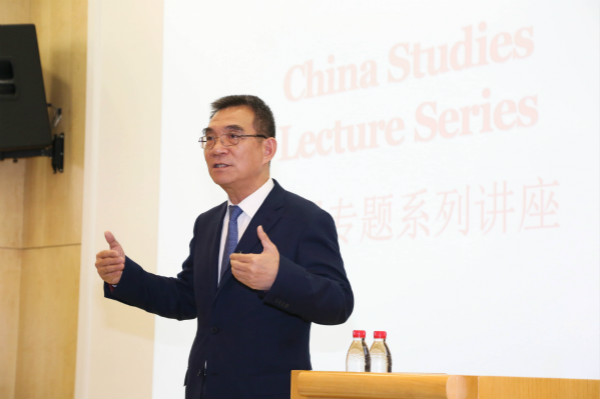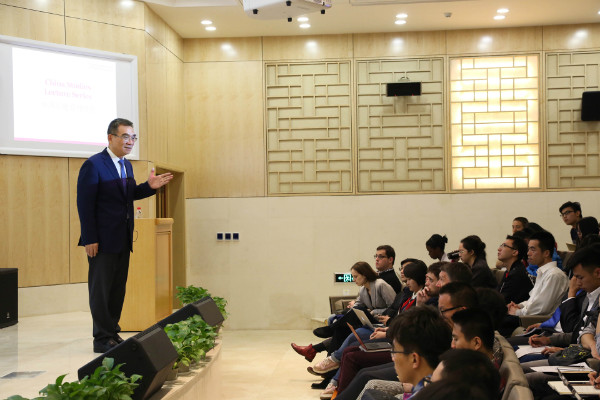For students of modern economics, the economic rise for China since 1979 is one of the most important events in recent human history. Before 1979, the Chinese economy was defined by isolation – exports and imports constituted only 9.5% of the country’s total GDP. But during the dramatic economic transformation, China has risen from one of the poorest countries in the world to become the world’s second largest economy, with an average annual GDP growth rate of 9.8%. Not only has China made great contribution to the world’s post-2008 economic recovery, but also to the improvement of human well-being as a whole – China has lifted 600 million people out of poverty.
As a part of the Yenching Academy China Studies Lecture Series, Prof. Justin Yifu Lin gave us an insider’s account of the miracle of Chinese economic growth during 36 years of reform and opening up. Lin is currently Professor and Honorary Dean of the National School of Development and Director of the Center for New Structural Economics at Peking University. He also served as the Senior Vice President and Chief Economist at the World Bank from 2008 to 2012.

China’s Poor Economic Performances Prior to Reform and Opening up
In the wake of the Communist takeover of China in 1949, Mao Zedong and other political leaders hoped to develop China into a respectable modern nation with strong military power. To achieve this goal, they adopted a plan to build advanced capital-intensive industries. This strategy enabled China to test nuclear bombs in the1960s and launch satellites in the 1970s. However, thousands of years of agricultural tradition had led to very minimal captive accumulation, and made it difficult for China to afford capital-intensive industries.
Lin stated, “From 1949 to 1978, China voluntarily gave up the latecomer advantages. The benefit of backwardness was not exploited until the transition from a command economy began in earnest. ” During this period of time, companies and firms in China had to live on government subsidies, protection and administrative directives. As a result of these measures, the overall economic performance was poor. Modern industries were established, but at the cost of resource misallocation.
Latecomer Advantages: the Reason Behind China’s Rapid Economic Development After 1979
“Economic development means development of income level,” Prof. Lin said. “If you want to increase income continually, you need to improve the level of labor productivity, and technological innovation and industrial upgrading are the two driving mechanisms behind productivity.” Meanwhile, the advantage of being a latecomer can be estimated by per capita GDP, an index which reflects a country’s average labor productivity and its overall technological and industrial achievement. The per capita GDP gap between China and developed countries therefore reflects the gap between them in terms of overall technological and industrial achievement.
Lin pointed out that China’s rapid economic development after reform and opening up is largely due to latecomer advantages. The Industrial Revolution marked the coming of modern economic growth with controlled experiments conducted by scientists and engineers in laboratories rather than experience-based technological innovation. Consequently, economies in countries such as Britain, the US, and Germany took off at an unprecedented speed. Developing countries can take full advantage of their latecomer status, in which technological innovation and industrial upgrading can be achieved by imitation, import, and integration of existing technologies and industries, all of which implies much lower research and development (R&D) costs. For example, it’s profitable for a “catch-up” country like China to absorb technology and adopt mature industries that already exists, for it ensures fast development at a much lower cost. Lin added that any developing country that can harness its latecomer advantage to achieve technological and industrial upgrading can grow faster than developed countries.

The Lost Decades: Developing Countries’ Stagnation After Reform
“Other socialist countries and many other developing countries also implemented aReform and Opening Up Policy, but to distinctly disappointing outcomes”, Prof. Lin continued. “For instance, in the 1980s and 1990s, the annual growth rate in developing countries was lower than in the pre-reform era while the frequency of crisis was much higher. ” In contrast to China’s extraordinary economic growth, the economic performances of other developing countries during the same period were so poor that it became known as the “lost decades” for developing world.
What is the main reason behind this divergence? Transition strategy matters. The disappointing economic performance of other developing countries demonstrated the “Washington Consensus” formula of rapid privatization and trade liberalization was not a cure-all in the transitional period. Granting unconditional freedom without government intervention is likely to fail, as in the case of Soviet Union’s drastic shift from national planned economy to liberal economy. What works in theory doesn't always do in practice because a successful transition strategy requires both pragmatic caution and a step-by-step, gradual approach. Otherwise, haste makes waste.
Thanks to Deng Xiaoping’s adoption of a dual-track approach – rather than the strongly market-based approach advocated by “Washington Consensus” – China’s robust economic growth was an exception against the waves of economic stagnation during the 1980s. Its success could be seen to justify controls and liberalization side by side. With government protection and subsidies to firms in priority sectors on the one hand and the liberalization of the entry of private enterprises and foreign investment into labor-intensive sectors on the other, Deng’s development strategy tapped the country’s comparative advantages, which had been repressed in the past.
China’s success, however, has not come without cost. Prof. Lin was not blind to the emerging problems coming with Reform and Opening Up. Issues such as income disparities, bribery, corruption and instability are the legacy of the dual track transition. According to Lin, “Income disparities have widened, owing in part to the continuation of distortionary policies in various sectors, including the domination of China’s four large state-owned banks, the near-zero royalty on mining, and monopolies in major industries, including telecommunications, power, and financial services. ”


A Path to Future: China’s Economic Growth Will Be Sustained
Given the fact that China has already experienced more than thirty years of rapid growth since Reform and Opening Up, people’s opinions diverge as to whether it is possible for this type of growth to last for another twenty or thirty years, or even longer. There is a growing bearishness among investors about the outlook for the Chinese economy. Some even go so far as to argue that China’s economy will crash. “Well, my answer to that question is very simple,” Lin said with a smile. “It depends on how large is the advantage of backwardness or your technological level comparedwith the highest income countries.”
Notwithstanding the headwinds blowing from the Euro zone crisis and the slump in demand worldwide, Lin believes China could continue its dynamic growth. He believes the evidence indicates that continued and sustainable economic growth is likely. According to new data, China’s economy grew by 6.7 percent year-on-year in the first quarter of 2016, suggesting economic resilience. Today, China is strengthening while the global environment is deteriorating. The fundamentals for the US economic recovery are still not solid, Lin said, and Japan and the EU have resorted to negative interest rates. Also, the economic conditions in Russia and Brazil – two of the five major emerging countries known as the BRICS, which also includes India, China and South Africa – have worsened. Recently, the IMF cut the 2016 global economic growth outlook to 3.2 percent. Yet it upgraded China’s growth forecast by 0.2 percentage points to 6.5 percent concurrently, thanks to the progress of the economy in the first quarter. Looking back at the investor sentiments over the last several months, it is obvious that the pessimism over China's economic prospects had been exaggerated. It once again shows that it is essential to look at the overall picture rather than just focus on a single aspect of China's vast economy.
Lin also added that further improvement of the market mechanism would guarantee a more stable and healthy economy. The legacy left by the dual track economic transition in the country’s financial structure, namely distortions in resource prices, administrative distortions, and the monopoly role of state-owned companies in a number of critical sectors, needs to be addressed as soon as possible. If not, inequality represented by the further widening of the urban-rural income gap will be explosive. Finally, Prof. Lin suggested ways that these distortions might be overcome. One policy he emphasized was the development of small and mediumbanks to support small and medium enterprises. Another is “building a new socialist countryside,” with emphasis on rural infrastructure, in support of investment and consumption.
Prof. Lin’s profound insight into the Chinese economy and Chinese growth was well received by the students and faculty present. He demystified the Chinese economic miracle by explaining it in language that students and non-economists can easily understand, and proposed a theoretical framework to analyze Chinese economic development across an important historical period.

Written by Huang Fangyuan